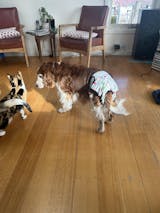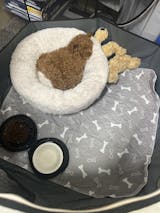Periodontal Disease in Dogs - Vet-Prescribed Ways to Prevent
You'd feel awful, wouldn't you, if you didn't brush your teeth even once? Having a lot of plaque and a foul taste in your mouth would most likely be too much for you. Your pocketbook definitely wouldn't feel so good after having to pay a high dentist cost to restore your oral health.
Consider what could happen to your dog's mouth if proper dental care is not provided. The short answer is dental disease in dogs.
Dental problems in dogs are somewhat prevalent. By three, more than 80% of dogs have dental disease, often known as periodontal disease. Dog dental illness has serious repercussions; thus, proper dental care is critical.
What Exactly is Periodontal Disease?
Periodontal disease is believed to affect more than two-thirds of dogs over three, making it the most frequent disease affecting pet dogs.

Periodontal disease is an infection and accompanying inflammation of the periodontium (the tissues surrounding the tooth). The periodontium is made up of four different tissues. They are the gingiva, cementum (the root surface covering), periodontal ligament (the ligament that connects the tooth root to the bone), and alveolar bone.
Types of Dental Disease in Dogs
Dog's gum diseases are caused by bacteria that can harm your dog's teeth, gum, bone and other supporting structure of dog's teeth. In most of the cases the the visible signs are to present until they are advance. Different types of dental illnesses affect dogs. Some are:
Gum Disease.
Endodontic Disease.
Developmental Abnormalities.
Trauma to the Face and Jaw.
Tooth Decay (Cavities)

We'll review the most prevalent ones below so you may be prepared ahead of time.
Reason for Tartar & It's Problems Caused by Periodontal Disease
Thousands of microorganisms live in the mouth including bacteria's that causes dental diseases in dogs. As these bacteria multiply on the tooth's surface, they produce an invisible covering known as plaque and organize into a biofilm. A biofilm is a cluster of bacteria built in such a way that it is resistant to removal and difficult for antibiotics to access. The dog's tongue and chewing activities spontaneously eliminate some of the plaque.

The plaque thickens and mineralizes when left on the tooth's surface, forming tartar. Tartar is a rough substance that attracts more plaque and causes it to "cling" to the tooth surface. Plaque microorganisms in touch with the gingiva (the gums) can cause inflammation (gingivitis). Gingivitis is always the first stage of periodontal disease and the only one completely reversible.
Is it Possible to Avoid Plaque and Tartar?
Daily dental cleaning using toothpaste specifically for dogs meant to be ingested is the best approach to avoid tartar buildup or other periodontal disease in dogs.
Special dog chew toys and treats may also aid in the reduction or postponement of plaque and tartar buildup. Some pet foods have been developed explicitly as dental diets that mechanically and chemically assist in plaque clearance. There are also water additives available.

Periodontal Disease in Dogs - Role of Dry Food
Pet food producers have designed dental diets for dogs to assist decrease the accumulation of plaque and tartar on your dog's teeth. Once tartar has formed, however, professional scaling and polishing under general anesthesia will be needed as it cannot simply be eliminated by dieting or brushing.

Symptoms of Broken, Chipped, or Cracked Teeth in Dogs
The tooth's pulp is protected by hard dentin and even harder enamel.
Two kinds of tooth fractures involve the tooth's crown. Simple fractures reveal the sensitive dentin. Complicated crown fractures involve the dentin and the pulp, which contains nerves and blood vessels.
What Causes Canine Tooth Fractures?
Most tooth fractures occur when dogs chew on overly complex items, such as ice cubes, bones, hard nylon chews, antlers, and horse and pig hooves. When a canine chew toy or dental treat is compressed, it should bend and "give."
The Treatment for Cracked Dog Teeth
If the pulp is exposed, root canal therapy or tooth extraction is the only therapeutic choice. If the tooth is not treated, infection will enter directly via the fracture site, leading to more severe disease.

You can offer the oral care your dog requires to prevent dental problems with kindness, patience, and dedication. Inquire with your veterinary healthcare team about tooth brushing tips.
Do Pets And People Suffer From The Same Dental Issues?
One of the most common dental diseases in dogs seen by veterinarians is dental disease. Over 80% of dogs over three years old have active dental disease.
Because few dogs exhibit clear indicators of dental illness, it is up to the dog's family and veterinarian to find this concealed and frequently painful ailment.
Many of the same or comparable oral disorders that affect humans can affect dogs. However, whereas tooth decay or cavities are the most frequent dental disease in humans, periodontal disease is the most common in dogs. Whether someone develops cavities or not relies on various factors, including environmental, bacterial plaque, and food, but eventually, there is tooth rot.
Tooth decay is uncommon in dogs, accounting for less than 10% of dental disorders. Periodontal disease and shattered teeth are the most common dental disorders in dogs.
Dog Teeth Cleaning Methods that Work Every time
You must make the dog teeth cleaning a pleasant activity for both of you if you want it to be a success. Make the experience enjoyable for your dog by praising and reassuring him throughout the treatment. Follow these instructions for the best results:
- Choose a peaceful time and place to begin.
- If your dog is small enough, secure him in your lap with his head turned away from you. If your dog is enormous, sit on a chair and have him sit alongside you so you can easily approach his mouth and teeth.
- Begin by rubbing your finger or a soft cloth back and forth over the outer surfaces of your dog's teeth, focusing on the area where the gum meets the tooth surface. To avoid getting accidentally bitten, keep your teeth on the exterior surfaces. For the first few lessons, rub the cloth along only a few teeth rather than the entire mouth, especially if your pet is unsure or apprehensive about the procedure.
- Allow your dog to taste a small amount of pet toothpaste from your finger after he is comfortable with you massaging his teeth. Do not use human toothpaste because it is not intended to be ingested.
- Apply a tiny bit of dog toothpaste to the towel and wipe it over your dog's teeth once he has accepted the flavor.
- When your dog is entirely comfortable with you wiping his teeth with a towel, it's time to introduce a dog toothbrush.

Process of Dog Teeth Cleaning At-Home
Keep your dog's teeth and gums neat and fresh to avoid stinky dog breath. With these simple home-care tips, you can keep your dog's teeth in tip-top shape.

Visit your veterinarian for a dental examination
The first step in caring for your dog's teeth is a trip to the veterinarian. The best method to manage your dog's teeth and mouth is to work with your local Vets team to develop a care plan suited to your pet's dental health. In addition, regular vet visits are necessary to keep your dog's teeth healthy throughout their lives. You wouldn't avoid the dentist for years, and neither should your pet!
Provide a dental diet
Switching to a scientifically proven dental care dry food for everyday meals is one of the simplest and finest ways to clean your dog's teeth. These diets contain uniquely shaped and textured kibble to scrub your dog's teeth while they chew, thereby reducing plaque and tartar buildup. Furthermore, the clinically established recipe helps to keep your pet's breath fresh every time they eat.
Every day, brush their teeth
Brushing our teeth is something we all do daily, but did you know you can also brush your pet's teeth? Vets advocate it as one of the most significant ways to treat dental disease in dogs, and even if you only do it for one minute each day, you'll notice a considerable improvement in your pet's teeth and overall health.
Give dental chews and treats
Dogs enjoy treats, and we enjoy seeing our best friends happy, so why not reward them with dental chews and snacks? These are beneficial to your pet's oral health since they encourage your dog to chew, and the mechanical movement helps remove plaque and tartar from their teeth. Explore our selection of tasty dental treats for dogs, but remember that this is only one component of cleaning your dog's teeth at home and should not be used as the primary approach.
Have fun with dental toys
Looking for a fun way to improve your pet's dental health? Consider using a dental chew toy! These amusing basics are available in various forms and sizes for all types of dogs and are designed to entertain your companion while refreshing their breath intellectually. Make sure to rotate your dog's dental toys regularly so they don't get bored and keep a range of textures on hand. To get a good blend, alternate rope and rubber toys.

Teeth Cleaning Guide to Avoid Periodontal Disease in Dogs
Keep it positive with these seven steps of dog teeth cleaning! Brushing should start with a younger dog or puppy as soon as possible, although we understand this isn't always practicable. The training process may take longer if you have an older dog, but it will be worth it! Making this a pleasurable experience for your dog is our best suggestion.
Let's go over each step with instructions for brushing your dog's teeth at home:
Ensure that your dog is calm and relaxed
The place you select to clean should be peaceful and free of distractions. Before cleaning, you should also take your dog for a stroll.
Prepare and set up your tools
Before you begin, always have a towel, toothbrush, toothpaste, and snacks ready in a quiet location.
Having a towel on hand for your dog to sit on is a good idea to keep them stable. Also, laying out your equipment on a towel is a terrific way to keep everything organized. You can also place your water dish on the towel because you'll probably drop a little when you dip the toothbrush.
It is critical to have adequate illumination
Lighting is quite crucial. We usually brush our dog's teeth outside on a dry, bright day. You might also use a headlamp. You'll want to observe where tartar is forming, which is much easier to view in daylight or, at worst, with a dependable light source!
Run your fingers along the gums and teeth of your dog
Begin by massaging the outside surfaces of your dog's teeth with your finger or a soft cloth to loosen very thin coatings of tartar. Make a gentle back-and-forth movement. Concentrate on the area where the gum meets the tooth surface. Keep your finger on the gum area if you don't want to get bit.

Ensure that your dog enjoys the toothpaste
This shouldn't be the first time you've tried toothpaste on your dog. Before cleaning your dog's teeth, you should experiment with different toothpaste flavors.
Before you begin, test the dog finger toothbrush
The brush you use should be appropriate for your dog's size. You can also use a toothbrush or gauze. Try using a gentle toothbrush made for babies.

There are two fundamental techniques. Go Slow!
Method 1: Use small circles
Work for up to 30 seconds on each side. This may require several sessions, so be patient with your dog and yourself.
Method 2: brush a few teeth at a time
You want to eventually work your way up to the entire side of the mouth. Begin with a few teeth at a time and take your time with these steps. When you first introduce brushing to a puppy, it will take some time.
Keep it light, and remember to include goodies
With your pets, always use small, highly appetizing treats. This should be a fun adventure for your dog. When you're finished, give your dog a treat!

Why Can't Dogs Use Human Toothpaste?
Most human toothpaste contains three components that can cause a dental disease in dogs:
Sodium fluoride
Fluoride is poisonous to dogs in high enough doses. Human toothpaste is intended to be washed out of the mouth rather than consumed. Do you realise how difficult it is to persuade a four-year-old, let alone a Labrador, not to swallow toothpaste?
The symptoms in the two scenarios are noticeably different.
The following are symptoms of acute fluoride poisoning caused by a dog eating human toothpaste:
- drooling
- nausea/vomiting
- restlessness
- urinary and faucal incontinence
- Weakness and even convulsions are possible.
Chronic poisoning symptoms caused by a dog swallowing human toothpaste include:
- teeth discoloration and mottling
- Limping on and off. (Two of the oddest clinical sign combinations I've ever written about in a dog health blog post!)
The bottom line is as follows:
Most human toothpaste contains fluoride in high enough proportions to harm a dog who ingests it daily, given enough time.
🚨 Even dog Toothpaste May Include Fluoride! 🚨
Pet toothpaste, on the other hand, is formulated to be swallowed. However, you still need to check the label before purchase because there is doggie toothpaste on the market that includes fluoride.
Sodium Lauryl Sulphate (SLS)
Manufacturers add Sodium Lauryl Sulphate (SLS) to achieve the foaming action. SLS is prevalent in soaps, shampoos, laundry detergents, and toothpaste. The Food and Drug Administration (FDA) considers SLS safe for short-term topical use (consumers disagree), but no studies have confirmed its safety when eaten.
SLS can induce gastrointestinal discomfort in dogs if consumed in large enough concentrations. Now you know "the rest of the story" on why pet toothpaste doesn't foam, as well as another reason why the answer to the question "Can you put human toothpaste on a dog?" is always "no."

Xylitol
You've probably heard about xylitol, a sugar alternative becoming increasingly popular in human diets and hygiene products. Ironically, xylitol has been linked to the prevention of tooth decay in humans, and it is thus added to toothpaste both as a sugar-free sweetener and because it may benefit oral health.
Unfortunately, xylitol is harming dogs. It can potentially induce two problems in a dog's system: low blood sugar and irreversible liver damage, both of which can be fatal.
Please practice reading the labels on everything you give your dog and looking for harmful ingredients in the list.
Conclusion
We hope you found these ideas on caring for your dog's teeth useful! Even though your dog's teeth appear in good condition, she should get her teeth checked every six to twelve months. Oral hygiene can save you money in the long run and your dog's life. Allowing her dental hygiene to deteriorate could lead to future more expensive and complicated treatments.
















